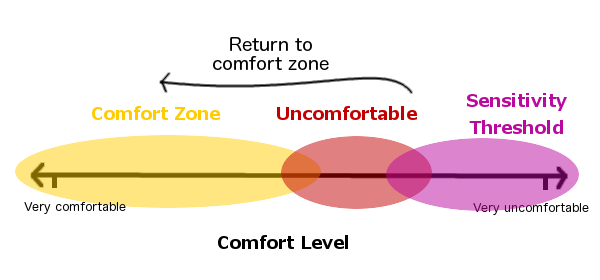
Self-improvement requires a healthy balance between going outside of your “comfort zone” to grow and learn new things, while also retreating back to your “comfort zone” when it’s time to relax and recharge.
In self improvement circles, there’s a lot of focus on “going outside of your comfort zone.”
Your “comfort zone” is typically seen as playing it safe. It’s when you choose comfort, familiarity, and security rather than novelty, risk-taking, and challenging yourself.
Indeed, it’s good to step outside of your comfort zone every now and then. We need to explore new things if we want to learn and grow, and that doesn’t always feel good right away.
One of my 10 commandments of self improvement is that we often need to “endure temporary pain and suffering” if we want to push ourselves to new limits. That’s still true. It’s impossible to change yourself if you don’t ever try anything new.
At the same time, our “comfort zone” has an unnecessarily bad reputation – and it isn’t something that needs to be completely avoided, but also embraced at the right times.
In fact, your comfort zone plays an integral role in your self improvement process, because it gives you an opportunity to relax and recharge yourself after an overwhelming situation.
Going outside of your “comfort zone” is naturally stressful and uncomfortable (by definition). It requires physical and mental energy to put yourself in situations you aren’t used to. If you are constantly pushing yourself, then that can quickly lead to frustration, fatigue, and failure.
The truth is you need to give yourself permission to “take it easy” every now and then.
You don’t always need to push yourself forward – you can even take a step back sometimes – and this is where your “comfort zone” becomes a very valuable resource to have.
Your Comfort Zone: Observe Your Sensitivity Threshold
When you push yourself outside of your comfort zone, it’s naturally stressful and challenging.
Everyone’s “comfort zone” looks different, depending on their personality and past experiences.
We’re all sensitive to different things. A very introverted person may feel uncomfortable in public places or large gatherings, while a very extraverted person may feel uncomfortable being alone or spending time in solitude.
One person’s comfort zone can be another person’s prison.
The key to using your comfort zone is to identify when you’ve hit your sensitivity threshold. Your “sensitivity threshold” is the amount of discomfort you can handle until an experience becomes too painful, negative, or damaging.
Experiencing discomfort in small and moderate doses can be healthy and rewarding, but once you’ve passed your sensitivity threshold then it’s time to retreat back to your “comfort zone” to relax and recharge.
Here’s what that looks like:

The “comfort zone” is what feels naturally familiar and safe to you. The “uncomfortable zone” is when you start experiencing stress, anxiety, or pain. The “sensitivity threshold” is when you’ve reached your limits, so it’s time to go back to safety.
All self improvement follows this process in one form or another.
For example, the goal of exercise and weight-lifting is to push yourself to your physical limits without hurting yourself. There’s an element of “No pain, no gain,” but at the same time you don’t want to go beyond your limits and do permanent damage (such as pulling a muscle, or breaking a bone, or passing out from fatigue or dehydration).
All self improvement requires a healthy balance between “comfort” and “discomfort.”
Identify your “sensitivity threshold” and be honest about where your limits are.
The truth is different people tolerate discomfort to varying degrees, some people even thrive best when they push themselves to extremes.
Those who are more risk-taking and thrill-seeking in their personality like to push themselves to the limits when given the chance, while others need to take smaller and safer risks.
Put another way, there are those who “dive right into a cold pool” while others need to “dip their toes in” first. There’s no right or wrong way, as long as you’re swimming by the end of it.
Your comfort zone can expand over time. Situations that used to make you feel extreme amounts of stress and anxiety can gradually become more normal and familiar to you with experience.
This is a core tenet of exposure therapy, a type of behavioral therapy that focuses on gradually exposing yourself to fearful situations so that you become more familiar and comfortable with them.
One common application of this is toward phobias. For example, if a patient is fearful of spiders, psychologists have found that you can “systematically desensitize” that fear by gradually exposing patients to spiders in a safe and controlled way.
The first step is to only show the patient pictures of spiders.
Then, after the patient’s fear response has gone down, the second step is to have the patient become comfortable being in the same room as a spider in a cage.
Then, a third step is having the patient in the same room with the spider without the cage. Slowly, the patient learns to get closer and closer to the spider (without getting too freaked out!).
And finally, if the treatment goes well, the patient becomes comfortable touching the spider and maybe even letting it crawl on his or her arm.
This is what a typical “exposure therapy” treatment looks like, but it can often take up to 8-12 sessions to go through all the different stages.
The goal isn’t to jump into your fear or anxiety headfirst without looking, but to start exposing yourself to small amounts of discomfort, then gradually work your way up to larger amounts of discomfort. By doing this, you systematically raise your “sensitivity threshold.”
The more you step outside of your comfort zone, the more you expand it. The more you familiarize yourself with the unfamiliar, the less scary it becomes.
At the end of each session, psychologists will often end with some type of relaxation exercise, such as a breathing meditation, mindful stretching, or progressive muscle relaxation to help patients recover after the stressful experience.
So even in a therapeutic setting, the “comfort zone” plays an important role.
Define Your Comfort Zone
Do you know what your “comfort zone” looks like?
What hobbies, activities, people, or environments allow you to step back and recharge your physical and mental batteries?
It’s important to define your comfort zone and understand it so that you can make the most of it.
What options are available to you when you need to recharge?
Create a list of “Relaxation Activities” and save it somewhere. Try to start with at least 5 different activities, but continue to add to it as you think of new things.
A resource like this reminds you that you have multiple choices available to you when you want to relax.
Common options include:
- Listening to your favorite music.
- Spending time outside in nature.
- Playing a fun video game.
- Getting social support from a close friend or family member.
- Reading a fiction book or watching a movie/TV show.
- Visualize a relaxing energy surrounding you.
- Create a safety symbol you can keep with you.
- Practice a grounding technique to center yourself in the present.
What works best for you when it’s time to relax?
Enter your email to stay updated on new articles in self improvement:
